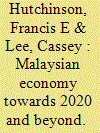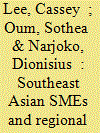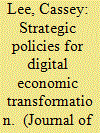| Srl | Item |
| 1 |
ID:
059169


|
|
|
| 2 |
ID:
144820


|
|
|
|
|
| Summary/Abstract |
Outward foreign direct investment (OFDI) has been an important element in Singapore’s economic strategy since the 1990s, with the government providing direct and indirect support to the internationalization process. Recent OFDI trends indicate that China has become an important destination for Singapore. In ASEAN, Singapore’s main investment markets are Indonesia, Malaysia and Thailand. Singapore’s OFDI has important sectoral dimensions, supported by evidence from econometric analysis. It is also important to distinguish between OFDI stock and flows.
|
|
|
|
|
|
|
|
|
|
|
|
|
|
|
|
| 3 |
ID:
191126


|
|
|
| 4 |
ID:
156964


|
|
|
|
|
| Summary/Abstract |
The primary objective of this paper is to trace the evolution of five-year development plans that have been formulated in Malaysia since the 1950s. Both internal and external factors have influenced the formulation and implementation of these plans. State bureaucracies played a crucial role in implementing the New Economic Policy in the 1970s. Economic reforms in the 1980s then reduced the independence of the planning bureaucracy by making bureaucrats more project-oriented and under the control of politicians. The corporate restructuring that followed the Asian Financial Crisis brought about greater involvement of corporate technocrats from Government Investment Companies (GICs) and Government Linked Companies (GLCs). Economic policy-making changed further under the Najib administration with increased centralization of development expenditure in the Prime Minister’s Department and greater use of private consultants. The current trajectory suggests a more centralized and flexible, but less transparent, approach to development planning.
|
|
|
|
|
|
|
|
|
|
|
|
|
|
|
|
| 5 |
ID:
156963


|
|
|
|
|
| Summary/Abstract |
In 1991, Malaysia’s then Prime Minister, Mahathir Mohamed, declared that the country should aim to be “fully-developed” and “industrialized” by 2020. To attain this goal, Malaysia would have to grow at an annual average of 7 per cent (in real terms) for thirty years. Prosperity and economic inclusiveness were overarching objectives, and education levels as well as scientific and technological progress were means to these ends.
|
|
|
|
|
|
|
|
|
|
|
|
|
|
|
|
| 6 |
ID:
132577


|
|
|
|
|
| Publication |
2014.
|
| Summary/Abstract |
Total Factor Productivity - TFP
Water Sector - Malaysia
Data Envelopment Analysis - DEA
Technological Improvements
Optimal Performance
Capital Investment
Social Reforms
Social Welfares
Economic Policy
Malaysia
Resource Utilization
Tariff Rates
Economic Liberalization
This paper analyses efficiency within the Malaysian water sector using the Data Envelopment Analysis (DEA) approach and the Malmquist Total Factor Productivity (TFP) Index. The results of the DEA show that the sector's mean technical efficiency was about 65 per cent over a ten-year period (1999 to 2008), which means that there is significant room for improvement in the area of resource utilization, whereby the sector can expand by 35 per cent whilst continuing to use the same amount of resources. The findings also indicate that Pulau Pinang state has the most efficient utilization of water and can therefore serve as a benchmark for optimal performance. The TFP analysis shows that the sector lags behind in the area of technological improvements, confirming an ongoing problem of inadequate capital investment. The findings indicate a positive relationship between efficiency and profitability and a negative relationship between efficiency and tariff rates. The relationship between privatization and efficiency, however, cannot be ascertained solely from the findings of this paper.
|
|
|
|
|
|
|
|
|
|
|
|
|
|
|
|
| 7 |
ID:
152285


|
|
|
| 8 |
ID:
191128


|
|
|